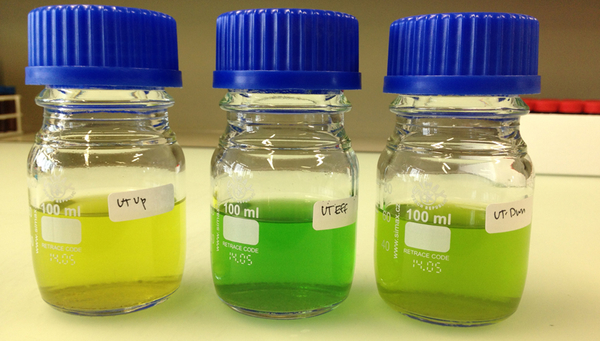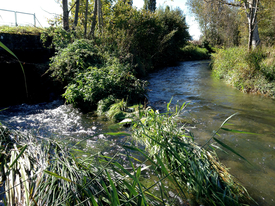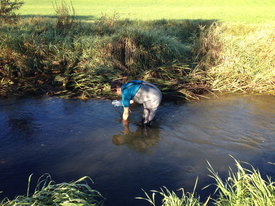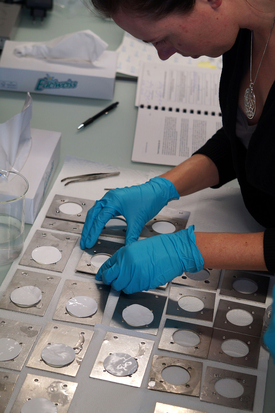Archive detail
Water quality: new insights thanks to a more efficient integrated approach
August 9, 2018 |
While increasing numbers of chemicals are entering surface waters, routine monitoring in Switzerland and the EU focuses on a relatively small number of compounds. These priority substances were originally defined as being of particular environmental concern. However, recent studies have shown that non-priority or even unidentified substances can also pose significant risks to aquatic life and human health. This was confirmed by a European research programme in which Eawag scientists also participated. The aim of EDA-EMERGE was to develop new effect-directed analysis (EDA) techniques, which were applied in a Europe-wide demonstration programme.
Combining biotesting and chemical analysis
In EDA, biotesting is combined with chemical analysis: while bioassays (e.g. involving human cells or zebrafish embryos) can detect toxicity in water samples, it often remains unclear what substances are causing the effects – hence the need for chemical analysis.
In the EDA-EMERGE programme, this approach was further optimised and simplified. Key components are selected bioassays and a newly developed device for the enrichment of micropollutants from large-volume water samples.
Unexplained adverse effects on organisms
Using the new methods, 37 scientists from 15 institutions investigated water quality near wastewater treatment plants (WWTPs) on four European rivers. One of the sites studied was the Urtene river (in the Bernese Midland) near the Moossee-Urtenenbach WWTP.
In samples from all four rivers, bioassays detected toxic effects on algae and fish embryos and endocrine effects which could not be explained solely in terms of the standard list of target compounds. The effects were observed, in particular, downstream of WWTP outlets.
Chemical analysis revealed that the samples also contained numerous substances not included on the target list. Frequently occurring compounds included, for example, gabapentin (an anticonvulsant), TMDD (a surfactant) and phthalimide (a fungicide transformation product). (For more information see: Tousova et al. 2017 / https://doi.org/10.1016/j.scitotenv.2017.06.032)
A closer look at the Urtenenbach
After the initial study phase, more detailed investigations were carried out on the Urtenenbach by a smaller (8-strong) team, comprising scientists from Eawag and INERIS (the French National Institute for Industrial Environment and Risks).
Marc Suter, Head of the Bioanalytics Group in Eawag’s Environmental Toxicology department, explains the background: “In the first phase of the study, the project team investigating all four rivers used familiar standard tests and divided the samples into four fractions.” In the second phase, new bioassays were used to study the mode of action of substances and mixtures in more detail. “We also collected far more samples, which were separated on the basis of physicochemical properties into 40 fractions – an extremely high resolution.” The more finely water samples are fractionated, the more clearly can the biological activity observed be attributed to individual compounds.
Precise results thanks to fine fractionation
This method was used to validate the initial study results and to exclude the possibility of laboratory findings being distorted by antagonists. Suter gives an example: “In the second series of tests, estrogenic activity was detected in 20 fractions. In the more crudely separated fractions used in the first test series, it would have been possible for antiestrogens (estrogen antagonists) to mask the effects of estrogens occurring in the same fraction, leading to false‑negative results.” High-resolution fractionation provides a better picture of reality.
Higher glucocorticoid activity
Overall, according to Suter, the results of the first and the second study differed less than had originally been expected. There were, however, some notable differences: “For example, with the aid of finer fractionation, we detected much higher glucocorticoid activity.” Glucocorticoids can have adverse effects on the immune system in humans and animals. This was shown in a zebrafish study carried out by Eawag doctoral student Anita Hidasi as part of the EDA-EMERGE programme (Hidasi et al. 2017 / https://doi.org/10.1016/j.ecoenv.2016.11.024).
Although the second phase of the project required major efforts, it yielded valuable insights: thanks to the combination of existing EDA techniques with new bioassays, Suter says, we now have a better understanding of various adverse effects observed in the laboratory. This is an important step towards improved risk assessment of surface water contaminants – particularly in WWTP effluents. In their conclusions, the scientists also emphasize the need for more research on the effects of glucocorticoids on aquatic organisms.
Financing
EDA-EMERGE is a 4-year Marie Curie ITN project, funded by the European Commission. It aims to train a new generation of young scientists in interdisciplinary techniques.
Publications
Photos
Jennifer Schollée deploying a passive sampler (Chemcatcher) at the Moossee‑Urtenenbach WWTP effluent discharge site. As a doctoral student, Schollée, together with Anita Hidasi, was part of the 7-strong Eawag team participating in EDA-EMERGE. The programme was explicitly designed to train early-career scientists. (Photo: Anita Hidasi, Eawag)




